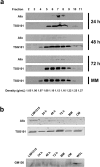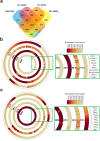Bovine milk-derived exosomes from colostrum are enriched with proteins implicated in immune response and growth
- PMID: 28725021
- PMCID: PMC5517456
- DOI: 10.1038/s41598-017-06288-8
Bovine milk-derived exosomes from colostrum are enriched with proteins implicated in immune response and growth
Abstract
Exosomes are extracellular vesicles secreted by multiple cell types into the extracellular space. They contain cell-state specific cargos which often reflects the (patho)physiological condition of the cells/organism. Milk contains high amounts of exosomes and it is unclear whether their cargo is altered based on the lactation stage of the organism. Here, we isolated exosomes from bovine milk that were obtained at various stages of lactation and examined the content by quantitative proteomics. Exosomes were isolated by OptiPrep density gradient centrifugation from milk obtained from cow after 24, 48 and 72 h post calving. As control, exosomes were also isolated from cows during mid-lactation period which has been referred to as mature milk (MM). Biochemical and biophysical characterization of exosomes revealed the high abundance of exosomes in colostrum and MM samples. Quantitative proteomics analysis highlighted the change in the proteomic cargo of exosomes based on the lactation state of the cow. Functional enrichment analysis revealed that exosomes from colostrum are significantly enriched with proteins that can potentially regulate the immune response and growth. This study highlights the importance of exosomes in colostrum and hence opens up new avenues to exploit these vesicles in the regulation of the immune response and growth.
Conflict of interest statement
The authors declare that they have no competing interests.
Figures





References
Publication types
MeSH terms
Substances
LinkOut - more resources
Full Text Sources
Other Literature Sources
Research Materials

